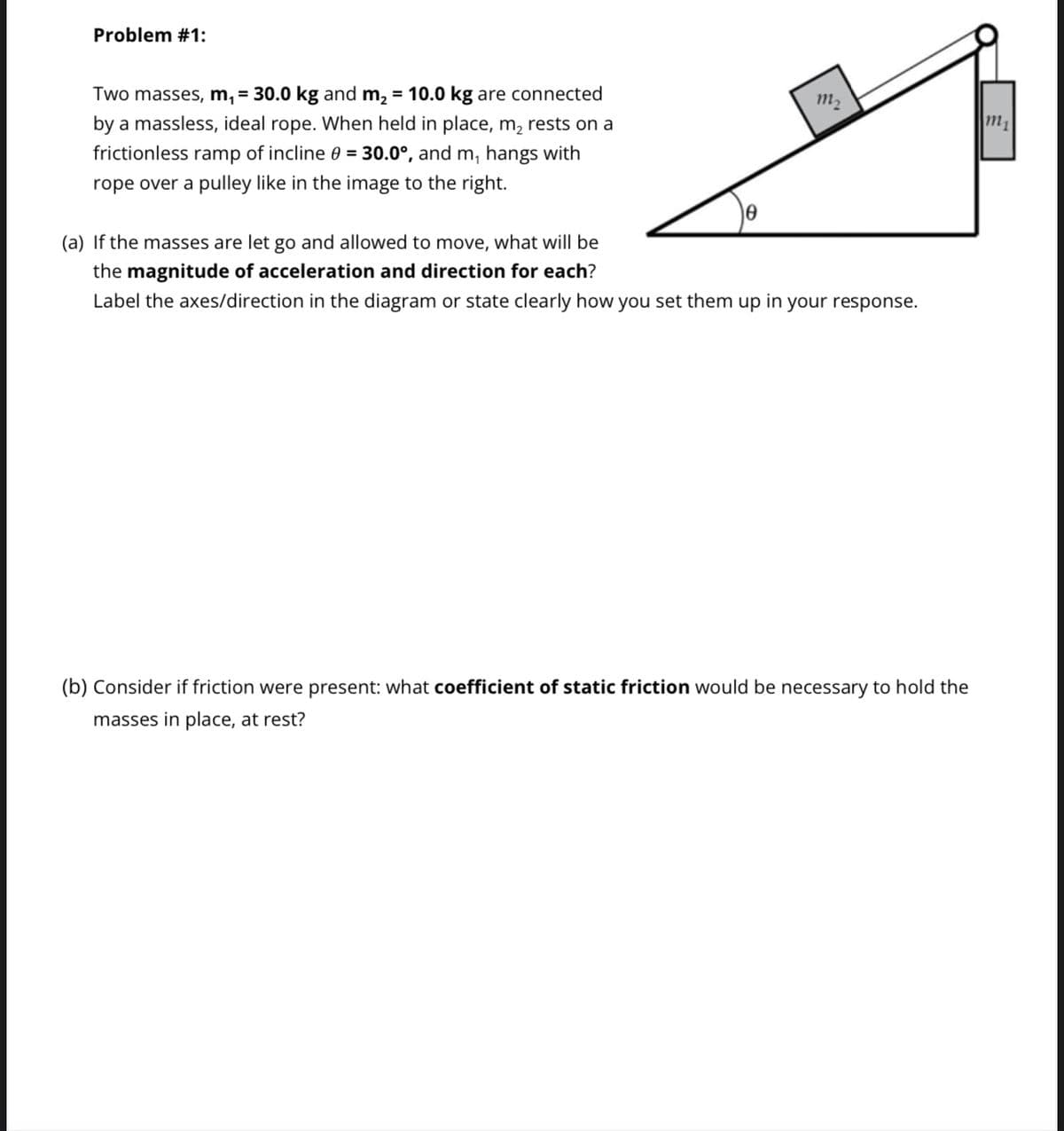Problem #1: Two masses, m₁ = 30.0 kg and m₂, = 10.0 kg are connected by a massless, ideal rope. When held in place, m₂ rests on a frictionless ramp of incline 0 = 30.0°, and m, hangs with rope over a pulley like in the image to the right. (a) If the masses are let go and allowed to move, what will be the magnitude of acceleration and direction for each? Label the axes/direction in the diagram or state clearly how you set them up in your response. (b) Consider if friction were present: what coefficient of static friction would be necessary to hold the masses in place, at rest? m₁
Problem #1: Two masses, m₁ = 30.0 kg and m₂, = 10.0 kg are connected by a massless, ideal rope. When held in place, m₂ rests on a frictionless ramp of incline 0 = 30.0°, and m, hangs with rope over a pulley like in the image to the right. (a) If the masses are let go and allowed to move, what will be the magnitude of acceleration and direction for each? Label the axes/direction in the diagram or state clearly how you set them up in your response. (b) Consider if friction were present: what coefficient of static friction would be necessary to hold the masses in place, at rest? m₁
University Physics Volume 1
18th Edition
ISBN:9781938168277
Author:William Moebs, Samuel J. Ling, Jeff Sanny
Publisher:William Moebs, Samuel J. Ling, Jeff Sanny
Chapter2: Vectors
Section: Chapter Questions
Problem 26P: In a tug-of-war game on one campus, 15 students pull on a rope at both ends in an effort to displace...
Related questions
Concept explainers
Rotational Equilibrium And Rotational Dynamics
In physics, the state of balance between the forces and the dynamics of motion is called the equilibrium state. The balance between various forces acting on a system in a rotational motion is called rotational equilibrium or rotational dynamics.
Equilibrium of Forces
The tension created on one body during push or pull is known as force.
Question

Transcribed Image Text:Problem #1:
Two masses, m₁ = 30.0 kg and m₂ = 10.0 kg are connected
by a massless, ideal rope. When held in place, m₂ rests on a
frictionless ramp of incline 0 = 30.0°, and m, hangs with
rope over a pulley like in the image to the right.
m₂
(a) If the masses are let go and allowed to move, what will be
the magnitude of acceleration and direction for each?
Label the axes/direction in the diagram or state clearly how you set them up in your response.
(b) Consider if friction were present: what coefficient of static friction would be necessary to hold the
masses in place, at rest?
m₁
Expert Solution
This question has been solved!
Explore an expertly crafted, step-by-step solution for a thorough understanding of key concepts.
This is a popular solution!
Trending now
This is a popular solution!
Step by step
Solved in 3 steps with 3 images

Follow-up Questions
Read through expert solutions to related follow-up questions below.
Follow-up Question
The masses are backwards on the 2 blocks, so the 30kg block is m2 the block on the ramp.
Solution
Knowledge Booster
Learn more about
Need a deep-dive on the concept behind this application? Look no further. Learn more about this topic, physics and related others by exploring similar questions and additional content below.Recommended textbooks for you

University Physics Volume 1
Physics
ISBN:
9781938168277
Author:
William Moebs, Samuel J. Ling, Jeff Sanny
Publisher:
OpenStax - Rice University

University Physics Volume 1
Physics
ISBN:
9781938168277
Author:
William Moebs, Samuel J. Ling, Jeff Sanny
Publisher:
OpenStax - Rice University